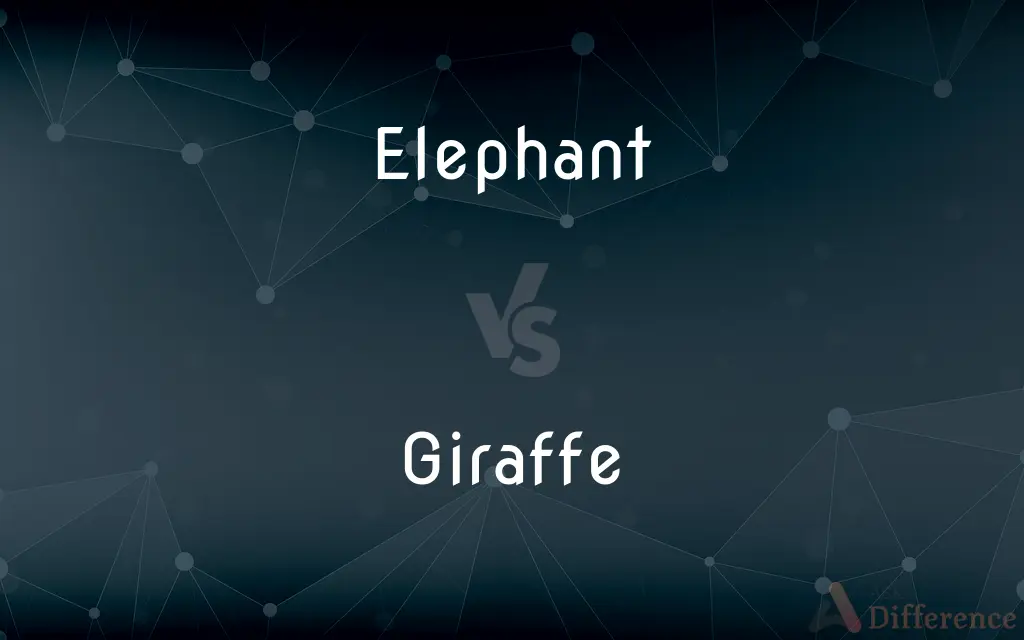Elephant vs. Giraffe — What's the Difference?
By Fiza Rafique & Maham Liaqat — Updated on March 26, 2024
Elephants, known for their massive size and intelligence, are the largest land animals, whereas giraffes are the tallest, recognized for their long necks and legs.

Difference Between Elephant and Giraffe
Table of Contents
ADVERTISEMENT
Key Differences
Elephants are distinguished by their large ears, which help regulate their body temperature, and their trunks, which are versatile tools for eating, drinking, and communication. On the other hand, giraffes are notable for their extremely long necks and legs, adaptations that allow them to reach high foliage in trees, a key advantage in their habitat.
Elephants have a highly structured social system, often led by a matriarch, and are known for their strong familial bonds and complex behaviors, such as mourning their after life. Whereas giraffes also live in social groups, their social structures are more fluid, with members freely joining or leaving groups.
In terms of habitat, elephants are found in diverse environments across Africa and Asia, ranging from savannas to forests. Giraffes, however, are primarily located in African savannas and open woodlands, where their height advantage can be fully utilized.
Elephants play a crucial role in their ecosystems as keystone species, modifying their environment in ways that benefit other species, such as creating waterholes. On the other hand, giraffes contribute to their ecosystems by acting as pollinators and seed dispersers, thanks to their diet of tree foliage.
Both species face threats from habitat loss and poaching, but elephants are particularly targeted for their ivory tusks. Giraffes face their own set of challenges, primarily habitat fragmentation and poaching for their meat and hide.
ADVERTISEMENT
Comparison Chart
Size
Largest land animal.
Tallest land animal.
Distinctive Features
Large ears and trunks.
Long necks and legs.
Social Structure
Matriarchal, complex social bonds.
Fluid group membership, less complex social bonds.
Habitat
Africa and Asia, diverse environments.
African savannas and open woodlands.
Ecosystem Role
Keystone species, environmental modifiers.
Pollinators, seed dispersers.
Diet
Herbivorous, varied including leaves, bark, fruit.
Herbivorous, mainly tree foliage.
Threats
Poaching (ivory), habitat loss.
Habitat fragmentation, poaching (meat, hide).
Lifespan
Up to 70 years.
Up to 25-30 years.
Reproduction
Slow breeding, long gestation (22 months).
Less gestation period (15 months), more frequent breeding.
Compare with Definitions
Elephant
Keystone species.
Elephants create waterholes used by other animals.
Giraffe
Vulnerable to habitat fragmentation.
Giraffe numbers have decreased due to loss of living spaces.
Elephant
Largest land mammals.
African elephants weigh up to 6,000 kg.
Giraffe
Pollinators and seed dispersers.
Giraffes spread the seeds of trees they feed on.
Elephant
Endangered due to poaching and habitat loss.
Elephant populations have declined significantly over the past century.
Giraffe
Tallest land animals.
Giraffes can reach heights of over 18 feet.
Elephant
Intelligent and social animals.
Elephants use their trunks to communicate and assist each other.
Giraffe
Known for their long necks and legs.
A giraffe's neck alone can be over 6 feet long.
Elephant
Herbivorous diet.
Elephants consume hundreds of pounds of plant matter daily.
Giraffe
Live in African savannas.
Giraffes use their height to eat leaves from tall trees.
Elephant
Elephants are a select group of proboscideans belonging to the family Elephantidae. They are the largest existing land animals.
Giraffe
The giraffe (Giraffa) is an African artiodactyl mammal, the tallest living terrestrial animal and the largest ruminant. It is traditionally considered to be one species, Giraffa camelopardalis, with nine subspecies.
Elephant
Any of several very large herbivorous mammals of the family Elephantidae native to Africa, South Asia, and Southeast Asia, having thick, almost hairless skin, a long, flexible, prehensile trunk, upper incisors forming long curved tusks of ivory, and, in the African species, large fan-shaped ears.
Giraffe
A large African mammal with a very long neck and forelegs, having a coat patterned with brown patches separated by lighter lines. It is the tallest living animal.
Elephant
Any of various extinct animals of the family Elephantidae.
Giraffe
An African ruminant mammal (Giraffa camelopardalis) having a very long neck and legs, a tan coat with orange-brown to black blotches, and short horns. It is the tallest land animal, often reaching a height of 5 meters (16 feet).
Elephant
A mammal of the order Proboscidea, having a trunk, and two large ivory tusks jutting from the upper jaw.
Giraffe
A ruminant, of the genus Giraffa, of the African savannah with long legs and highly elongated neck, which make it the tallest living animal; yellow fur patterned with dark spots, often in the form of a network; and two or more short, skin-covered horns, so-called; strictly speaking the horn-like projections are ossicones.
Elephant
(in particular) Any member of the subfamily Elephantinae not also of the genera Mammuthus and Primelephas.
Giraffe
A giraffe unicycle.
Elephant
(figuratively) Anything huge and ponderous.
Giraffe
(Cockney rhyming slang) A laugh.
Are you having a giraffe?!
Elephant
Synonym of elephant paper
Giraffe
A very tall individual.
Elephant
Used when counting to add length, so that each count takes about one second
Let's play hide and seek. I'll count. One elephant, two elephant, three elephant...
Giraffe
An African ruminant (Giraffa camelopardalis formerly Camelopardalis giraffa) related to the deers and antelopes, but placed in a family (Giraffidae) by itself; the camelopard. It is the tallest of quadriped animals, being sometimes twenty feet from the hoofs to the top of the head. Its neck is very long, and its fore legs are much longer than its hind legs. There are three types, having different patterns of spots on the pelt and different territories: the Reticulated Giraffe, the Masai Giraffe, and the Uganda Giraffe. Intermediate crosses are also observed.
Elephant
Ivory.
Giraffe
Tallest living quadruped; having a spotted coat and small horns and very long neck and legs; of savannahs of tropical Africa
Elephant
(xiangqi) A xiangqi piece, that is moved two points diagonally, may not jump over intervening pieces and may not cross the river.
Elephant
A mammal of the order Proboscidia and family Elephantidae, of which two living species, Elephas maximus (formerly Elephas Indicus) and Loxodonta Africana (formerly E. Africanus), and several fossil species, are known. They have five toes, a long proboscis or trunk, and two large ivory tusks proceeding from the extremity of the upper jaw, and curving upwards. The molar teeth are large and have transverse folds. Elephants are the largest land animals now existing. The elephant is classed as a pachyderm.
Elephant
Ivory; the tusk of the elephant.
Elephant
Five-toed pachyderm
Elephant
The symbol of the Republican Party; introduced in cartoons by Thomas Nast in 1874
Common Curiosities
Are giraffes solitary animals?
No, they live in groups, but with fluid membership.
How do giraffes eat from tall trees?
They use their long necks and tongues to reach high foliage.
How do elephants affect their environment?
They modify landscapes, creating habitats for other species.
What do elephants eat?
A varied diet of leaves, bark, and fruit.
Why do elephants have large ears?
To help regulate their body temperature and communicate.
What social structure do elephants have?
They live in matriarch-led families with complex social bonds.
Why are elephants poached?
Mainly for their ivory tusks.
What challenges do giraffes face?
Primarily habitat fragmentation and poaching.
How long do elephants live?
They can live up to 70 years.
What role do giraffes play in their ecosystem?
They act as pollinators and help in seed dispersal.
What do giraffes primarily feed on?
Mainly tree foliage.
How do both animals contribute to biodiversity?
Elephants as environmental engineers and giraffes as key agents in pollination and seed dispersal.
How often do giraffes breed?
They have a shorter gestation period and can breed more frequently than elephants.
What is the gestation period of an elephant?
About 22 months.
What is the lifespan of a giraffe?
Up to 25-30 years.
Share Your Discovery

Previous Comparison
Peritoneum vs. Omentum
Next Comparison
Sassy vs. AttitudeAuthor Spotlight
Written by
Fiza RafiqueFiza Rafique is a skilled content writer at AskDifference.com, where she meticulously refines and enhances written pieces. Drawing from her vast editorial expertise, Fiza ensures clarity, accuracy, and precision in every article. Passionate about language, she continually seeks to elevate the quality of content for readers worldwide.
Co-written by
Maham Liaqat













































